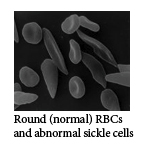Sickle Cells
| Tweet |
By Billie Rubin, Hemoglobin’s Catabolic Cousin, reporting from the labs of Stanford Blood Center
Sickle cells are abnormally shaped red blood cells (RBCs) caused by a mutation of the hemoglobin gene (Hgb S). Their less flexible, sickle-like shape leaves them unable to get through small capillaries, resulting in obstructed blood vessels in many organs. In addition, because of this sickle shape, the RBCs are sequestered and destroyed in the spleen at a faster rate than normal cells.
It’s been theorized that this abnormal sickle trait (i.e. one copy of the sickle gene) makes the RBCs more resistant to the malaria parasite, so this mutation may have provided an evolutionary advantage when inherited from only one parent. But when kids inherit Hgb S from both parents, it leads to a serious sickle cell disease and anemia. This can be a painful disorder and often requires many life-saving transfusions of normal RBCs.

